NRG Energy Bundle
Can NRG Energy Maintain Its Competitive Edge?
NRG Energy stands as a pivotal force in the integrated power sector, constantly adapting to the dynamic energy landscape. From its origins as a wholesale energy generator, NRG has evolved, embracing a diversified portfolio that includes renewables, and navigating the shifts from traditional fossil fuels. This evolution is crucial to understanding its current market position and future prospects.
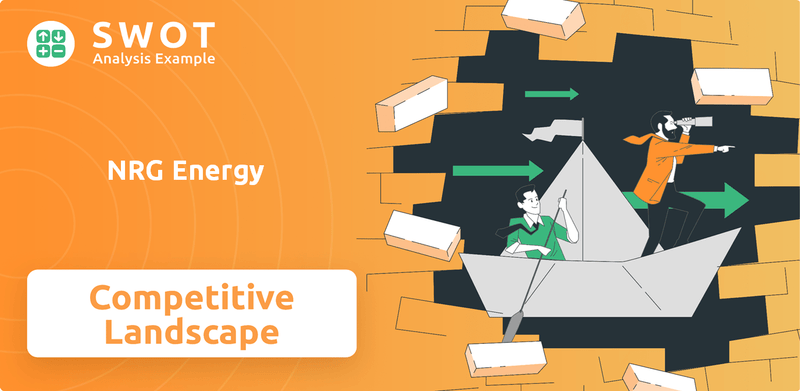
To truly understand NRG Energy's position, we must dissect its NRG Energy SWOT Analysis and the broader energy industry analysis. This comprehensive analysis will explore NRG Energy's competitive landscape, examining its key rivals and market share within the power generation companies sector. We'll also delve into its strategic partnerships and recent acquisitions, assessing how NRG Energy's business model and pricing strategies contribute to its overall competitive advantages and growth strategy in the renewable energy market.
Where Does NRG Energy’ Stand in the Current Market?
NRG Energy holds a significant position in the U.S. power industry, functioning as one of the largest integrated power companies. The company provides electricity and natural gas to a diverse customer base, including residential, commercial, industrial, and wholesale clients. Its geographic presence spans key competitive markets such as Texas, the Northeast, and California.
The core operations of NRG Energy involve power generation from various sources, including natural gas, coal, nuclear, and renewables, alongside retail electricity and natural gas services. Over time, NRG has strategically shifted its position through acquisitions and divestitures to optimize its generation fleet and expand its retail customer base. The acquisition of Direct Energy in 2021 significantly boosted its retail footprint, adding over three million customers across North America.
As of early 2025, NRG Energy continues to show strong financial health, reflected in its consistent revenue streams and strategic investments in renewable energy and customer-centric solutions. While specific market share figures fluctuate by region, NRG consistently ranks among the top energy providers in its core markets. The company leverages its scale and diversified asset base to maintain a competitive edge in the NRG Energy competitive landscape.
NRG Energy consistently ranks among the top energy providers in its core markets. While precise market share data varies by region, the company maintains a strong position in key areas like Texas, the Northeast, and California. This competitive standing is supported by its extensive customer base and diversified asset portfolio.
NRG Energy serves a diverse customer base, including residential, commercial, industrial, and wholesale clients. The company offers electricity and natural gas services, and its retail footprint expanded significantly with the acquisition of Direct Energy. This expanded customer base enhances its ability to offer bundled energy solutions.
NRG Energy demonstrates strong financial health, as reflected in its consistent revenue streams. The company's strategic investments in renewable energy and customer-centric solutions contribute to its financial stability. The company's ability to maintain a competitive edge is supported by its financial strength.
NRG Energy has strategically positioned itself through acquisitions and divestitures to optimize its generation fleet and expand its retail customer base. The Direct Energy acquisition in 2021 was a key move. This strategic approach has solidified its position as a leading integrated energy provider.
NRG Energy's market position is characterized by its integrated operations, diverse customer base, and strategic initiatives. The company's focus on renewable energy and customer-centric solutions enhances its competitive advantage. For a deeper dive into NRG's strategic approach, consider reading about the Growth Strategy of NRG Energy.
- Market Share: Consistently ranks among the top energy providers in core markets.
- Customer Base: Serves a diverse customer base, including residential, commercial, and industrial clients.
- Strategic Moves: Acquisitions like Direct Energy have expanded its retail footprint.
- Financial Health: Demonstrates strong financial performance with consistent revenue streams.
NRG Energy SWOT Analysis
- Complete SWOT Breakdown
- Fully Customizable
- Editable in Excel & Word
- Professional Formatting
- Investor-Ready Format
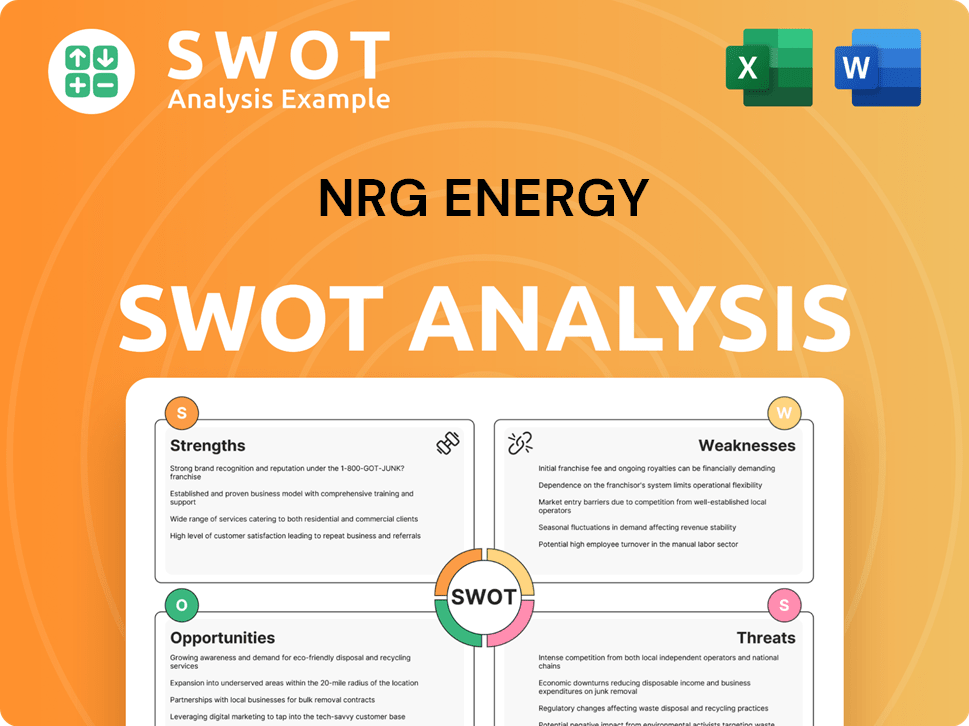
Who Are the Main Competitors Challenging NRG Energy?
The NRG Energy competitive landscape is shaped by a dynamic energy market, where the company faces both direct and indirect competition. Understanding NRG Energy competitors is crucial for assessing its market position and strategic direction. This analysis considers various players, from established utilities to emerging renewable energy developers, to provide a comprehensive view of the challenges and opportunities facing NRG Energy.
The energy industry is undergoing significant transformation, driven by technological advancements, changing consumer preferences, and environmental concerns. This evolution impacts NRG Energy market share and necessitates continuous adaptation to maintain a competitive edge. The competitive landscape is constantly evolving due to mergers, acquisitions, and the increasing importance of renewable energy sources.
NRG Energy operates in a highly competitive energy market, facing challenges from a diverse array of direct and indirect competitors. Key direct competitors include other large integrated utilities and independent power producers. For example, Vistra Corp. is a significant rival, particularly in the Texas market, where both companies have substantial generation assets and retail operations. Exelon Corporation, with its strong presence in regulated markets and significant nuclear fleet, competes with NRG in certain wholesale power markets and through its retail subsidiaries in some regions. Southern Company, another major utility, competes through its vast generation capacity and distribution networks, especially in the Southeast.
Direct competitors include large integrated utilities and independent power producers that offer similar services. These companies compete directly with NRG for market share in generation, retail, and wholesale energy markets.
Vistra is a key competitor, especially in Texas, with significant generation assets and retail operations. Vistra's focus on both conventional and renewable generation presents a direct challenge to NRG's market share.
Exelon competes with NRG in wholesale power markets and through its retail subsidiaries. Exelon's strong presence in regulated markets and its nuclear fleet make it a significant competitor.
Southern Company competes through its vast generation capacity and distribution networks, particularly in the Southeast. This company presents a direct challenge to NRG's market share in those regions.
Indirect competition comes from renewable energy developers, energy efficiency solution providers, and distributed generation technologies. These competitors impact NRG by reducing overall electricity demand and offering alternative energy solutions.
NextEra Energy Resources, a subsidiary of NextEra Energy, is rapidly expanding its renewable portfolios. This expansion poses a long-term competitive threat as the energy transition accelerates.
The energy industry is marked by constant change, with mergers and acquisitions reshaping the competitive landscape. The increasing adoption of energy storage solutions and demand-side management programs further impacts traditional generation businesses. Understanding these dynamics is crucial for evaluating NRG Energy's position.
- Renewable Energy Growth: The expansion of renewable energy sources, such as solar and wind, by companies like NextEra Energy Resources, is a significant trend. According to the U.S. Energy Information Administration (EIA), renewable energy sources accounted for approximately 22% of U.S. electricity generation in 2023, and this percentage is projected to increase.
- Energy Storage: The deployment of energy storage solutions is growing, impacting the demand for traditional generation. The global energy storage market is expected to reach a value of $154.9 billion by 2028, according to a report by MarketsandMarkets.
- Market Consolidation: Mergers and acquisitions continue to reshape the industry, leading to larger, more diversified competitors. For example, recent consolidations among smaller energy retailers and renewable developers have created stronger rivals.
- Customer Preferences: Changing customer preferences for cleaner energy sources and energy efficiency solutions are also driving competition. According to a 2024 survey, 68% of consumers are willing to pay more for renewable energy.
- Regulatory Changes: Regulatory changes and government incentives, such as tax credits for renewable energy projects, significantly influence the competitive environment. The Inflation Reduction Act of 2022 provides substantial incentives for renewable energy development.
For more insights into how NRG Energy approaches its market strategy, consider reading about the Marketing Strategy of NRG Energy.
NRG Energy PESTLE Analysis
- Covers All 6 PESTLE Categories
- No Research Needed – Save Hours of Work
- Built by Experts, Trusted by Consultants
- Instant Download, Ready to Use
- 100% Editable, Fully Customizable
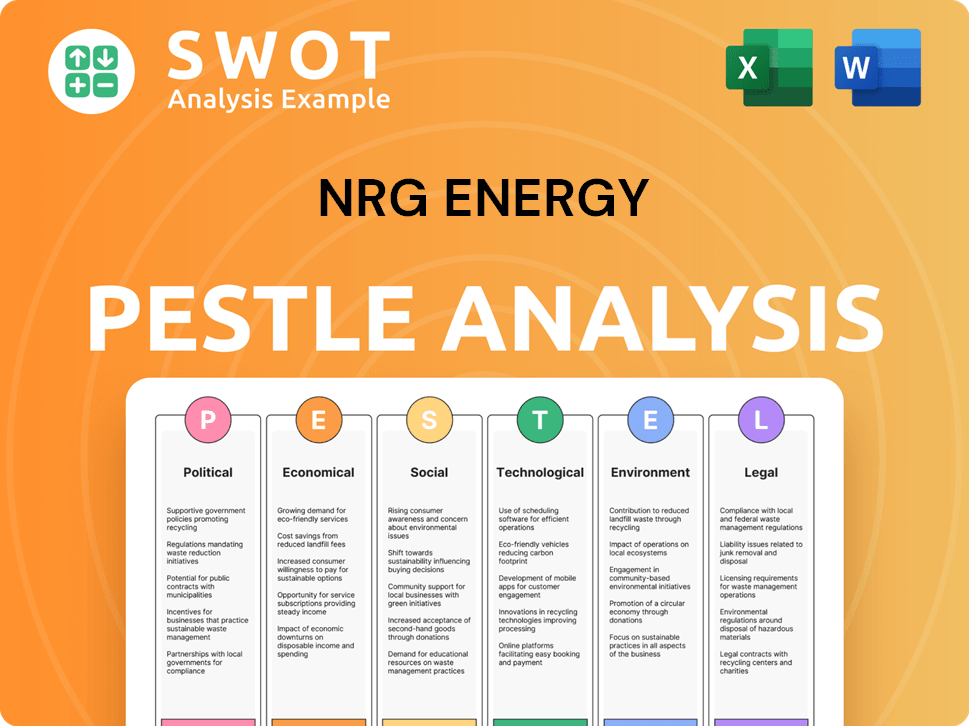
What Gives NRG Energy a Competitive Edge Over Its Rivals?
Understanding the competitive advantages of NRG Energy is crucial for anyone analyzing the NRG Energy competitive landscape. The company has strategically positioned itself in the energy market through a combination of diverse assets and customer-focused strategies. This approach allows it to navigate the complexities of the energy industry analysis and maintain a strong market position.
One of the key strengths of NRG Energy is its integrated business model. This model combines power generation with retail energy services, a strategy that directly impacts its NRG Energy market share. By controlling both the production and distribution of energy, NRG Energy can offer more stable and reliable services to its customers. This integration also provides the company with valuable insights into customer needs and preferences, allowing for more tailored energy solutions.
The company's focus on sustainability and renewable energy further enhances its competitive edge. As the demand for clean energy grows, NRG Energy's investments in renewable projects position it favorably. This commitment not only attracts environmentally conscious customers but also aligns with the broader trend towards a more sustainable energy future. For a deeper dive into the company's financial structure, consider exploring the Revenue Streams & Business Model of NRG Energy.
NRG Energy operates a diverse portfolio including natural gas, coal, nuclear, and renewable sources. This diversification helps in mitigating risks associated with fuel price volatility. The mix ensures a more stable and reliable power supply, allowing the company to adapt to market changes.
The acquisition of Direct Energy significantly expanded NRG's retail customer base. This integration connects generation directly to end-users, creating a stable revenue stream. This model enhances customer relationships and provides a competitive advantage over pure-play generation companies.
NRG Energy benefits from extensive operational experience and economies of scale in power generation. Efficient infrastructure management is a key factor in maintaining profitability. This operational excellence allows the company to compete effectively in the market.
The company focuses on customer-centric solutions including home energy services and energy management tools. These offerings build brand loyalty and generate additional revenue streams. This focus on customer needs differentiates NRG and strengthens its market position.
NRG Energy's competitive advantages are multifaceted, enabling it to maintain a strong position. These advantages include a diversified generation portfolio, an integrated retail customer base, and operational efficiency.
- Diversified Portfolio: A mix of energy sources, including renewables, reduces reliance on any single fuel.
- Integrated Model: Combines generation and retail, ensuring stable revenue and customer relationships.
- Operational Efficiency: Benefits from economies of scale and efficient infrastructure management.
- Customer Focus: Offers home energy services and management tools to build brand loyalty.
NRG Energy Business Model Canvas
- Complete 9-Block Business Model Canvas
- Effortlessly Communicate Your Business Strategy
- Investor-Ready BMC Format
- 100% Editable and Customizable
- Clear and Structured Layout
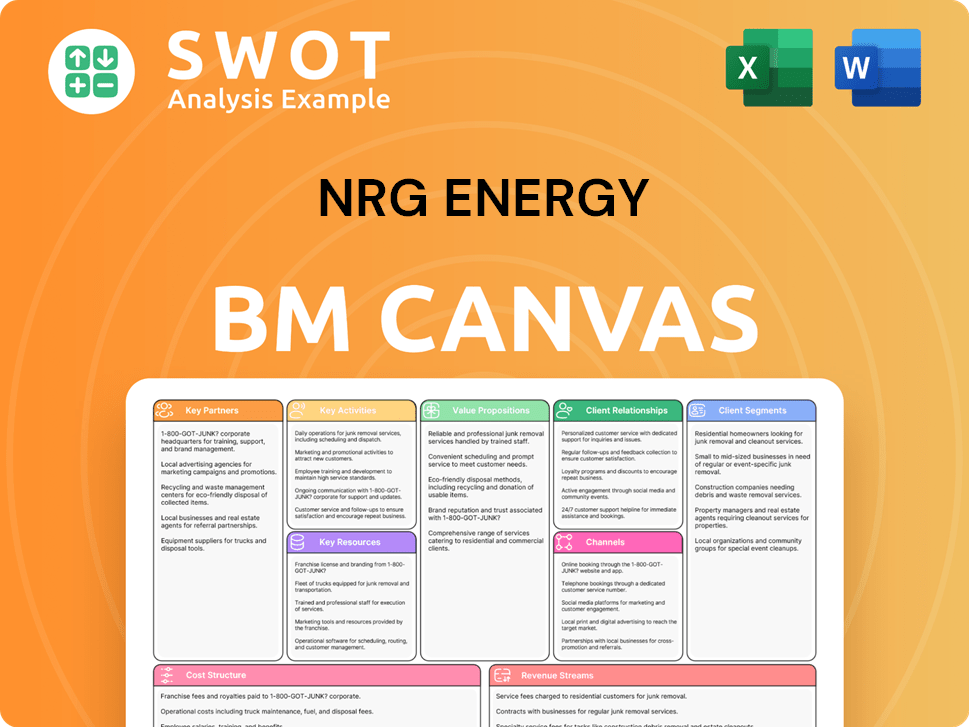
What Industry Trends Are Reshaping NRG Energy’s Competitive Landscape?
The energy industry is in constant flux, and understanding the NRG Energy competitive landscape requires a close look at current trends, future challenges, and potential opportunities. The company's position is influenced by shifts toward renewable energy, digitalization, and evolving consumer demands. This analysis aims to provide a comprehensive view of the forces shaping NRG Energy's future, considering both the hurdles and the prospects that lie ahead. For a deeper dive into the company's ownership structure, you can read more about Owners & Shareholders of NRG Energy.
The energy industry analysis highlights several critical factors that impact NRG Energy. These include the transition to cleaner energy sources, the increasing importance of digital solutions, and the ongoing need to adapt to geopolitical and economic uncertainties. These elements collectively shape the NRG Energy market share and overall strategic direction.
The primary trend is the push toward decarbonization and renewable energy. This is driven by regulations, consumer preferences, and technological advancements. The digitalization of the energy sector, including smart home solutions and energy management systems, is also a significant trend. These trends require substantial investments and strategic adjustments from power generation companies like NRG Energy.
Managing the decline in demand for traditional fossil fuels is a major challenge. Navigating complex regulatory environments and potential disruptions from new market entrants are also significant hurdles. Geopolitical events and their impact on fuel prices pose persistent challenges. These factors can affect NRG Energy's financial performance.
Expanding the renewable energy portfolio, especially in solar and wind, is a key opportunity. Investing in battery storage and electric vehicle charging infrastructure also presents new market avenues. Strategic partnerships and acquisitions in emerging energy technologies could further enhance its competitive position. These opportunities can contribute to NRG Energy's growth strategy.
NRG Energy aims to maintain a balanced energy mix, enhance customer offerings, and embrace technological innovation. This includes focusing on a mix of energy sources, improving customer services, and adopting new technologies. The company's approach to NRG Energy sustainability initiatives is also crucial.
To maintain a strong position, NRG Energy needs to adapt to the changing energy landscape. This involves strategic investments, partnerships, and a focus on innovation. Understanding NRG Energy competitors is critical for making informed decisions.
- Renewable Energy Investments: Increasing investments in solar and wind projects to meet growing demand. In 2024, the renewable energy market is projected to continue expanding.
- Digital Transformation: Leveraging digital platforms to offer smart home solutions and energy management services.
- Strategic Partnerships: Forming alliances to access new technologies and markets.
- Customer-Centric Approach: Enhancing customer engagement through personalized energy solutions.
NRG Energy Porter's Five Forces Analysis
- Covers All 5 Competitive Forces in Detail
- Structured for Consultants, Students, and Founders
- 100% Editable in Microsoft Word & Excel
- Instant Digital Download – Use Immediately
- Compatible with Mac & PC – Fully Unlocked
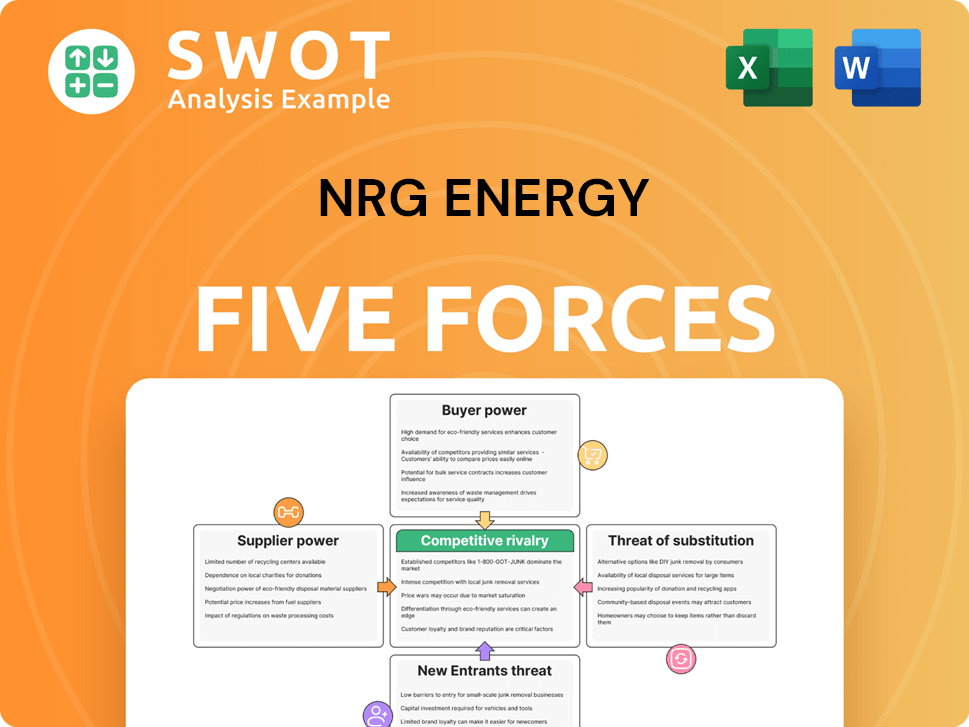
Related Blogs
- What are Mission Vision & Core Values of NRG Energy Company?
- What is Growth Strategy and Future Prospects of NRG Energy Company?
- How Does NRG Energy Company Work?
- What is Sales and Marketing Strategy of NRG Energy Company?
- What is Brief History of NRG Energy Company?
- Who Owns NRG Energy Company?
- What is Customer Demographics and Target Market of NRG Energy Company?
Disclaimer
All information, articles, and product details provided on this website are for general informational and educational purposes only. We do not claim any ownership over, nor do we intend to infringe upon, any trademarks, copyrights, logos, brand names, or other intellectual property mentioned or depicted on this site. Such intellectual property remains the property of its respective owners, and any references here are made solely for identification or informational purposes, without implying any affiliation, endorsement, or partnership.
We make no representations or warranties, express or implied, regarding the accuracy, completeness, or suitability of any content or products presented. Nothing on this website should be construed as legal, tax, investment, financial, medical, or other professional advice. In addition, no part of this site—including articles or product references—constitutes a solicitation, recommendation, endorsement, advertisement, or offer to buy or sell any securities, franchises, or other financial instruments, particularly in jurisdictions where such activity would be unlawful.
All content is of a general nature and may not address the specific circumstances of any individual or entity. It is not a substitute for professional advice or services. Any actions you take based on the information provided here are strictly at your own risk. You accept full responsibility for any decisions or outcomes arising from your use of this website and agree to release us from any liability in connection with your use of, or reliance upon, the content or products found herein.